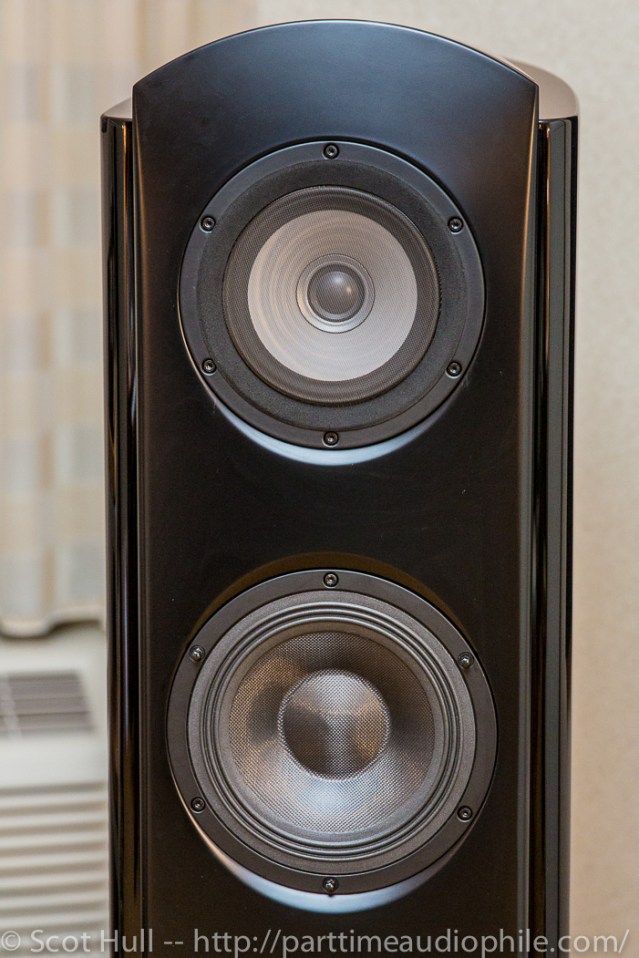 George and Carolyn Counnas of Zesto Audio were spinning records all weekend long, but when I walked in, it was Cat Stevens’ shivering voice that sent me down the spirals of memory to a place where all I could do was clap and grin. Just wow.
George and Carolyn Counnas of Zesto Audio were spinning records all weekend long, but when I walked in, it was Cat Stevens’ shivering voice that sent me down the spirals of memory to a place where all I could do was clap and grin. Just wow.
I probably ought to have saved that for last, though. Oh well.
The system George was fiddling about with was complicated, so let’s do that first.
From the beginning, we had a Dynavector XX2 MkII cartridge ($1,985) mounted on a 10″ Tri-Planar U2 tonearm ($6,200).
This was attached to the newly updated Merrill Williams Audio REAL 101.2 turntable ($7,200). This upgrade includes new mounting boards that can accommodate tonearms up to 12″ long, and an under-the-platter-mounted strobe. The plinth is no longer clothed in aluminum, either, but a phenol that’s supposed to provide better isolation/damping.
WyWires steps in here to carry the signal with their newest, the Diamond Series. Alex Sventitsky, the designer, has been on something of a tear, lately; it’s great to see him not sitting still. Less than four years old, WyWires has seen quite a bit of evolution over that time, a testament to the learning process any new manufacturer goes through. Their first offering, the Silver Series, was scaled down into a more affordable offering, called Blue. Lessons learned led to a new Silver, the Silver v2 and from there to the Gold, which added Bybee tech. With the limited availability there, Alex came up with an alternative he liked even better, which he called Platinum which was released last year at RMAF.
Diamond marks an entirely new approach for WyWires, which has been known for a heavy use of unique Litz topologies to create its signature sound, one I find just a hair to the hi-fi side of the tonal line, adding a touch of speed and air for systems that wander toward the warm. With Diamond, Alex leverages six different Litz geometries, each optimized for particular frequency, and adds to this a high-purity copper solid core wire. The resulting combination was voiced on loudspeakers from Fritz, TAD and Daedalus. The result, Alex claims, is an extremely balanced cable with a remarkably neutral sound, still with exemplary detail and separation, but now with a fuller tone and a more balanced and flat response. Not cool. Not warm. Full. These cables are quite complex to build, and are hand constructed in-house, with each pair taking one person pretty much all day to make. Prices for the speaker cables start at $7,995/set and $4,595 for interconnects. A Diamond Series power cord, as well as an upgrade to the joint Daedalus Audio project, the Power Broker distribution systems ($2,499 for Silver), is coming shortly.
A Zesto Audio Andros 1.2 vacuum tube phono stage ($4,700) picked up from here. The Andros, already an award-winning phono pre, has also gotten a bit of a tweak recently, which includes:
- 10 position MC load, from 20 to 1000 Ohm and more positions in the sweet zone between 200 to 1000 Ohms
- 2 position MM loading, 47K &15K to accommodate a wider range of cartridges
- 67dB of gain
- +6V max output
- Same sonic signature
- Improved circuitry design and component value upgrades
- Enhanced grounding scheme
- Binding post moved to accommodate shorter ground wires
- Lower noise
- New feet
From there, we find a Zesto Audio Leto line stage ($7,500). This pre won an award from TAS, and features a quartet of tubes (two each of 12AX7 and 12AU7) along with the distinctive Zesto mirror-and-flair. This pre is fully balanced and includes a remote. It’s active, perhaps obviously, adding 12dB of gain, and features 100kΩ inputs and 150Ω outputs, unusual for a tube design and extremely helpful in system-matching.
I asked George why there wasn’t a phono option for the Leto and he looked at me as if I were insane. “Theres just no room,” he said, apologetically. “We could do it, but it would mean a whole new platform, a big one, and the end result would probably cost more than the separates — and not have the benefits of dedicated designs.” So much for my business consulting gig.
The star of this show was the Bia 120, a fully balanced amplifier, putting 60 watts into each loudspeaker. The amp is big. It may not look like it, but it’s all Banner-just-before-he-turns-green and heavy. Lots of iron packed in there. Driver tubes are a quartet of 12AU7 feeding a quartet of KT88 tubes (KT120 tubes can also be used). The topology is a Class-A, ultra linear push-pull with a toroid power transformer and a choke-based, dual-mono power supply. There are also discrete taps for 4Ω, 8Ω and 16Ω loads.
The front end of this system was a pair of TAD Evolution One loudspeakers ($29,800). These are not the Great Big TAD speakers, but they sure do sound like them — see that concentric driver up on the top of the cabinet? Looks very like what the Reference speakers carry, and quite frankly, I wasn’t missing out sitting here, in the sweet spot chair. But I did admire the chutzpah. Anyone showing with a TAD speaker is asking for problems as these speakers are lasers pointed at system bottlenecks. Choosing them as your references? Big, brassy confidence there.
This was a very happy 20 minutes. I might have hissed and spit when the record ended. The textures were crazy good. Sure, that new Tea for the Tillerman release is shockingly, frighteningly, great, but it doesn’t sound like that at home!
Another Best-in-Show contender.



























